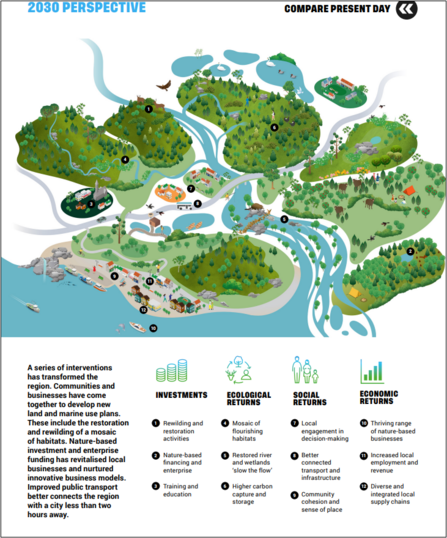Restoring thriving communities through rewilding
We are facing one of the, if not the, greatest challenges of the 21st century – the combined climate and ecological emergencies. The pandemic has also highlighted the importance of retaining human wellbeing and access to green space. These three issues are all linked, and nature based solutions can help with all of them. Rewilding is not a silver bullet, but in the right places it can help to restore nature, habitats, a healthy environment, and thriving communities. We need to catalyse a transition from extractive to regenerative economies. Rewilding Britain believes that we can do so by putting nature at the heart of a green economic recovery.
What is rewilding?
Rewilding is about hope. It’s popular, works well alongside traditional farming, and should be locally led. It offers a powerful solution for tackling the nature and climate emergencies, while benefiting people and communities.
Rewilding is the large-scale restoration of nature to the point it can take care of itself – restoring habitats and natural processes, and where appropriate reintroducing missing species. Rewilding encourages a balance between people and the rest of nature so that we thrive together. It can provide opportunities for communities to diversify and create nature-based economies; for living systems to provide the ecological functions on which we all depend; and for people to reconnect with wild nature.
Rewilding is one of the tools to help mitigate the climate and ecological crises. Over half of Britain’s species are declining, with one-in-seven crashing towards extinction. A study found that the UK is one of the world's most nature-depleted countries, with on average about half its biodiversity left - far below the global average of 75%. It means the UK is in the bottom 10% globally for biodiversity.
Rewilding can be achieved by restoring native woodlands, moorlands, peatlands, rivers and marine habitats, without losing productive farmland or our farming heritage. It isn’t going to be appropriate everywhere – Rewilding Britain are calling for rewilding of 5% of Britain, with an additional 25% in nature recovery. Rewilding is not going to be suitable for our most productive farmland, and will be part of a mosaic of regenerative agriculture, forestry, and other land uses. We should consider rewilding as one element to this mosaic to give us an opportunity to reverse the declines in wildlife and to restore the ecosystems that we all rely on.
Rewilding & the Rural Economy
It is a common misconception that rewilding is about excluding people from the land, closing the gate and walking away resulting in fewer job opportunities. Letting natural processes take the lead implies that fewer people will be needed to work the land, and traditional and culturally important rural communities will be lost.
Our new Rural Economies report paints a picture, quite literally, of how a nature-based economy in the year 2030 would differ from today. Nature is rebounding in this imagined landscape: there are more saplings and scrub regenerating on the hills, the rivers are cleaner and less prone to flooding thanks to beaver reintroductions, and the peat bogs have become net carbon sinks again after being restored.

